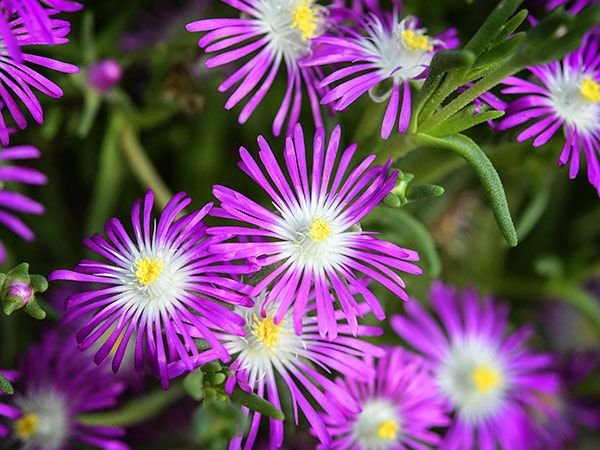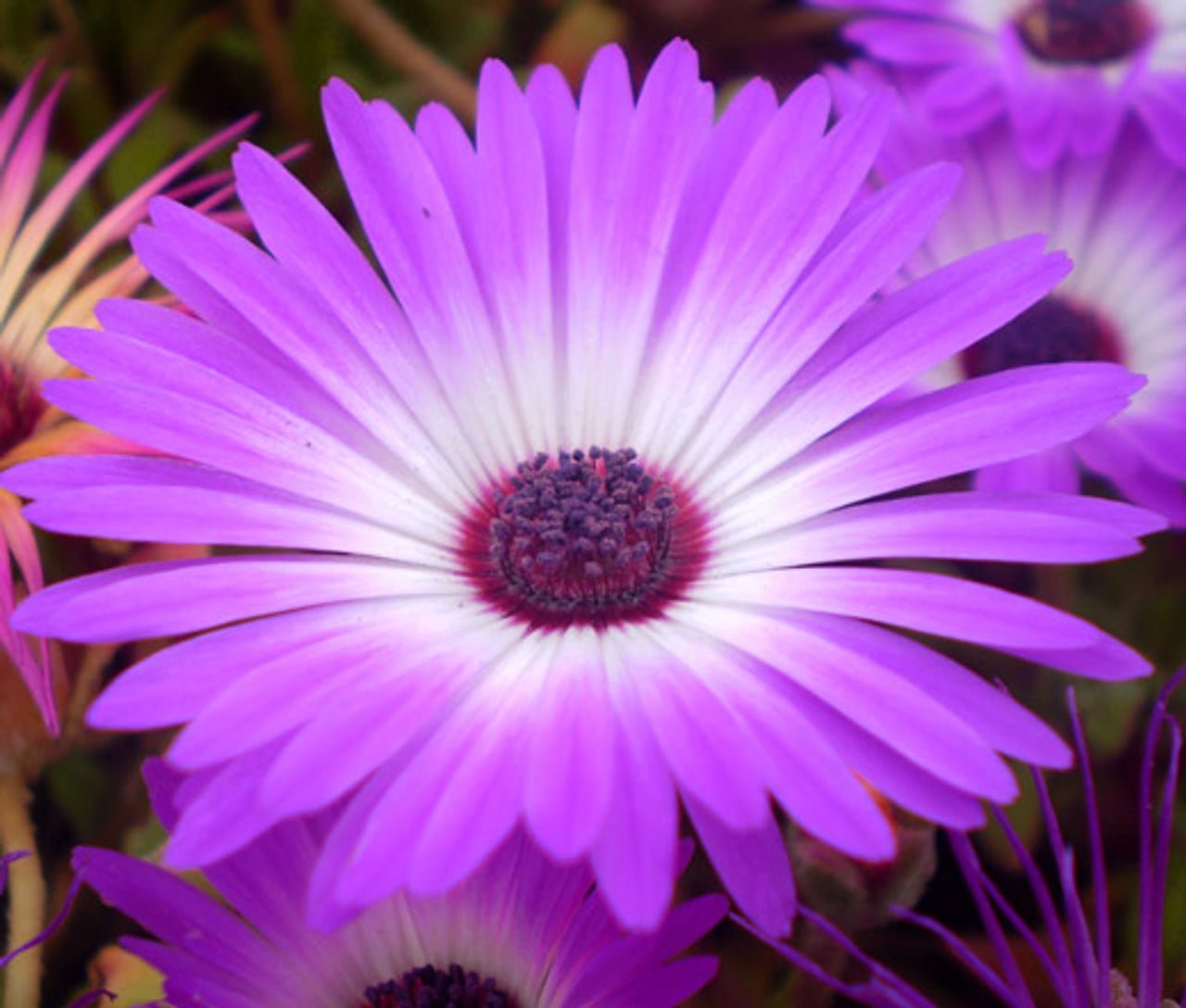The Purple Stardust Ice Plant is a wonderful attraction that is as delicious as it is beautiful! The bright, shimmering blooms and succulent foliage of this fast-growing perennial form a beautiful flowering ground cover that is also edible and nutritious. Leaves and stems can be enjoyed raw or cooked, offering a slightly salty, delicious flavor. An excellent spinach substitute in salads! Prefers slightly dry soil once the plants are started. Enjoy this crispy treat in your garden this summer!
Purple Stardust Ice Plant
| Common Names or AKA Names: |
|
| Botanical Name: | Delosperma floribundum |
| Family: | Aizoaceae |
| Plant Type (Zone 8b): | Perennial |
| Hardiness Zones: | Zones 5 through 9 |
| Mature Size: | 4″ – 8″ inches tall, 10″ – 18″ inches wide |
| Native Area: | South Africa |
| Bloom/Harvest Time: | June to September |
| Sun/Light Exposure: | 6 to 12 hours of Light. |
| Planting Depth: | Surface Sow |
| Soil Preferences: | Average/Poor/Dry well-Drained |
| Soil pH: | pH 5.5-7.2 |
| Aquaponically-Friendly: | |
| Hydroponically-Friendly: | LEARN MORE |
DESCRIPTION:
The Delosperma Floribunda is a succulent perennial plant that is native to South Africa. The Hardy Ice Plant Purple Stardust seeds can be started indoors 4–6 weeks before the last frost, or the seeds can be sown directly outdoors in spring after the temperatures have warmed. The Delosperma Floribunda Stardust spreads vigorously and forms a dense carpet of shiny, olive–green, succulent foliage. It also blooms in late spring and blooms repeatedly through summer and fall with magnificent, daisy–like, lilac–purple flowers that have large white centers. The blooming Ice Plant Stardust also attracts bees and butterflies.
The Ice Plant Purple Stardust grows fast and forms a beautiful flowering ground cover. It is also drought and heat-tolerant and low-maintenance, so dry and hot areas are not a problem for this plant. The Hardy Stardust Ice Plant is also suitable for patio pots, window boxes, containers, alpine and rock gardens, wildlife gardens, low maintenance gardens, and coastal gardens. The Delosperma Floribunda seeds germinate in 2-3 weeks without any special treatment, and the Hardy Ice Plant thrives in full sun, average to poor, sandy, gravelly, dry to medium well-drained soil.
USE:
Culture & Cultivation:
This plant should only be grown in full sunlight. It prefers dry to average moisture levels with very well-drained soil, and will often die in standing water. It is considered to be drought-tolerant, and thus makes an ideal choice for a low-water garden or xeriscape application. It is not particular as to soil pH, but grows best in sandy soils. It is somewhat tolerant of urban pollution. This is a selected variety of a species not originally from North America. It can be propagated by cuttings; however, as a cultivated variety, be aware that it may be subject to certain restrictions or prohibitions on propagation.
Being a succulent, prefers full sun and very dry, sandy, poor soil. These plants don’t tolerate well wet, heavy soils and much fertilization. Ice Plant propagates by division, cuttings or seeds.
If you want to learn more about cultivating this specific plant, you might want to check out our online courses where we have plant specific mini courses in addition to our standard fully packed courses and master gardening courses.
Planting & Care:
Ice plants can take the form of everything from a spreading ground cover to a bushy sub-shrub, depending on the type. Ice plants are used in sunny but sheltered desert gardens, in rock gardens, on slopes, or as ground cover or edging plants. Individual plants often spread around 2 feet, though they occasionally can spread even more than that. They also work well as container plants that easily fill the top and eventually spill over the sides of the container.
Make sure your planting location has a lot of sun and fast-draining soil. Space plants 15 to 18 inches apart, as they will quickly spread to fill the empty space. Each spring, prune out any winter-killed stems.
PLANTING INSTRUCTIONS
Sow Indoors: Winter (4-6 weeks before last frost)
Sow Outdoors: Spring/Fall
Seed Depth: Surface sowing – press seeds slightly into the soil
Germination Time: 7-21 Days
Growing new plants can be difficult at times but not to worry Green Grass Grove Academy is here to help! We are excited to offer Online Courses on plant care and other Gardening and Homesteading Courses. Our goal is to provide you with the knowledge and skills necessary to become a successful gardener. Our Online Courses are designed to be self-paced and to be completed at your convenience. Courses contain invaluable information to help you become the ultimate Gardener! In addition, Our Courses have entertaining multimedia, quizzes, and a final exam to test your knowledge. Upon completion of each course, you are eligible to receive a certificate of completion. Some of our most popular courses include Aquaponics/Hydroponics, Plant Pathology, Seeds & Seedlings, Microgreens, Plant Mini-Courses, and Insect Pest & Nutrients Management.
So what are you waiting for? Come on over to Green Grass Grove Academy and let us help you become the ULTIMATE GROWER!
Watering:
The hardy Ice Plant loves well–drained soil and should be watered sparingly in the growing season. Once your plants become established, you can provide weekly watering in dry climates if no rainfall is expected. The important thing to remember is that your plant needs to dry out before the winter months arrive. If you get snow in your region, make sure to mulch around your plants to protect them from the cold weather. Too much water can result in root rot, so it‘s important not to over-water them.
Harvesting:
To harvest the flowers, cut the stem about an inch below the flower. You can then place them in a vase with fresh water. Change the water every few days to keep the flowers fresh. If you want to dry the flowers, cut the stems and hang them upside down in a dark, dry area.
Aphids | Mealybugs | Snails & Slugs
Take Our Online Insect Pest Management Course to become an expert at dealing with these pests and others too!
Learn More About This Plant!
Ice plants are generally low-maintenance additions to the garden. They don’t need much watering or feeding, and they naturally have an attractive form.
Most ice plant species have a fairly quick growth rate, though some only have a moderate growth rate.
Yes. The leaves and flowers of the ice plant can be harvested to eat fresh in salads or used in stir fries.
- As an evergreen perennial, this plant will typically keep its form and foliage year-round.
- Stardust Ice Plant is a fine choice for the garden, but it is also a good selection for planting in outdoor pots and containers. Because of its spreading habit of growth, it is ideally suited for use as a ‘spiller’ in the ‘spiller-thriller-filler’ container combination.
- Once established, water your ice plant sparingly during the growing season. One watering every two weeks should be sufficient during periods when there is no rainfall, though a weekly watering might be necessary during hot weather.
- In mid-autumn, stop watering your plants to help prepare them for winter. Without water, they will shrink back and harden to better resist freezing temperatures.
The information in this post is NOT medical/nutrition advice, as we are not doctors or nutritionists. This information is for informational/entertainment purposes only and is not a substitute for professional medical advice, nutrition advice, diagnosis or treatment. If you have any concerns or questions about your health or nutrition intake, you should always consult with a doctor or other licensed and qualified healthcare professional.
Green Grass Grove Plant Profiles
No posts found!






